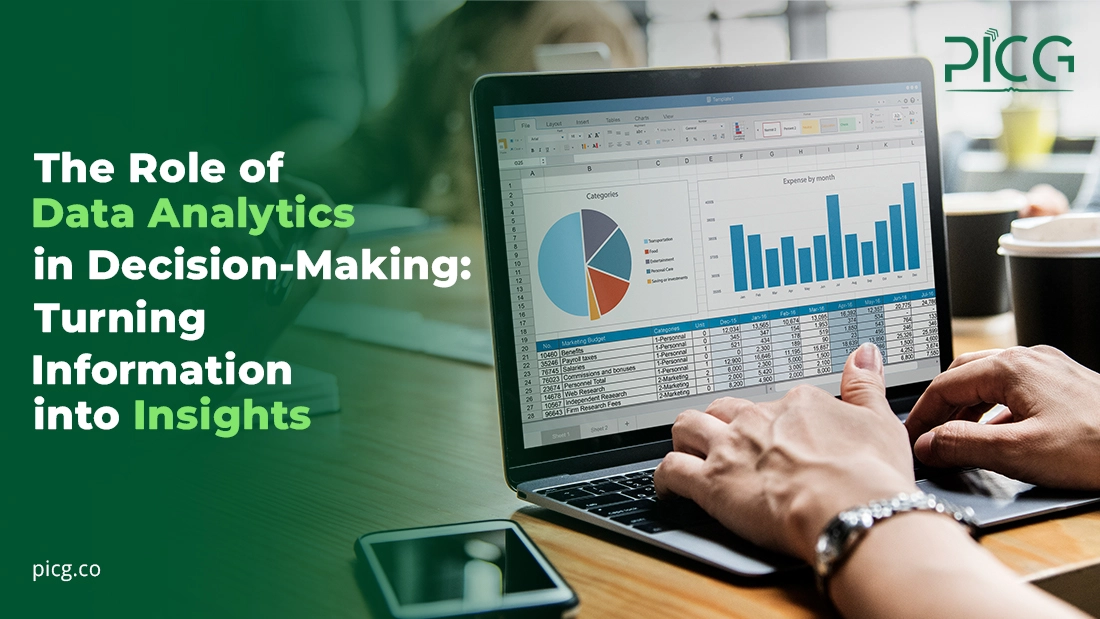


PICG

In today's data-driven world, businesses are inundated with information from various sources. To thrive and make informed decisions, companies must harness the power of data analytics. This blog delves into the pivotal role of data analytics in decision-making and how it can transform raw data into actionable insights.
Data analytics is the process of examining, cleaning, transforming, and interpreting data to uncover meaningful patterns, correlations, and trends. It involves various techniques, including statistical analysis, machine learning, and data visualization. The ultimate goal is to extract valuable insights that can guide decision-making.
Informed Decision-Making: Data analytics provides decision-makers with a comprehensive understanding of the current business landscape. It empowers them to make decisions based on facts and evidence rather than intuition.
Competitive Advantage: Companies that leverage data analytics gain a competitive edge. By identifying opportunities and challenges early, they can adapt swiftly and stay ahead of the competition.
Cost Reduction: Analytics can reveal inefficiencies and areas where cost savings are possible. This is especially valuable during economic downturns or when resources are constrained.
Improved Customer Experience: Understanding customer behavior and preferences enables businesses to tailor products and services, leading to higher customer satisfaction and loyalty.
Data analytics involves a systematic process to extract insights from data:
Data Collection: The process begins by collecting data from various sources, such as customer interactions, website traffic, or sales records.
Data Cleaning and Preparation: Raw data is often messy and may contain errors or inconsistencies. Data analysts clean and preprocess the data to ensure accuracy and uniformity.
Exploratory Data Analysis (EDA): Analysts explore the data to identify patterns and outliers. This step helps in formulating hypotheses and understanding the data's structure.
Statistical Analysis and Modeling: Analysts use statistical techniques and machine learning algorithms to uncover relationships and trends in the data.
Data Visualization: Visualizations, such as charts and graphs, are created to communicate insights effectively. Visual representations make complex data more understandable.
Interpretation and Insights: Finally, analysts interpret the results, drawing meaningful insights and actionable recommendations.
Data analytics can be categorized into several types, each serving a different purpose:
Descriptive Analytics: Describes what has happened in the past, often using summary statistics and visualizations. It's fundamental for understanding historical data.
Diagnostic Analytics: Focuses on why something happened. It delves deeper into data to identify the root causes of trends or issues.
Predictive Analytics: Uses historical data to make predictions about future events or trends. It's valuable for forecasting demand or customer behavior.
Prescriptive Analytics: Goes a step further by providing recommendations for actions. It helps businesses make decisions by suggesting the best course of action based on data.
Data analytics is used across industries to drive decision-making:
Retail: Retailers use analytics to optimize pricing, manage inventory, and create personalized shopping experiences.
Healthcare: In healthcare, data analytics helps improve patient outcomes, optimize resource allocation, and identify disease patterns.
Finance: Financial institutions use analytics for risk assessment, fraud detection, and portfolio management.
Manufacturing: Manufacturers optimize production processes, reduce downtime, and predict maintenance needs using analytics.
Marketing: Marketers leverage data analytics to understand customer behavior, segment audiences, and measure campaign effectiveness.
While data analytics offers immense potential, it comes with challenges:
Data Quality: Garbage in, garbage out. Poor data quality can lead to inaccurate insights. Ensuring data accuracy and reliability is paramount.
Privacy and Ethics: Handling customer data must be done ethically and in compliance with regulations. Data privacy is a growing concern.
Skill Gap: There's a shortage of data analytics talent. Companies must invest in training or consider outsourcing to bridge this gap.
Integration: Data often resides in different systems. Integrating these systems to enable holistic analysis can be complex.
In the digital age, data is the lifeblood of decision-making. Data analytics empowers businesses to transform raw data into actionable insights, helping them make informed, strategic decisions.
Whether it's improving operational efficiency, enhancing customer experiences, or gaining a competitive edge, data analytics plays a pivotal role in shaping the success of modern organizations.
As businesses continue to evolve, those that harness the power of data analytics will be better equipped to thrive in an increasingly complex and competitive landscape.